Welcome to DU!
The truly grassroots left-of-center political community where regular people, not algorithms, drive the discussions and set the standards.
Join the community:
Create a free account
Support DU (and get rid of ads!):
Become a Star Member
Latest Breaking News
Editorials & Other Articles
General Discussion
The DU Lounge
All Forums
Issue Forums
Culture Forums
Alliance Forums
Region Forums
Support Forums
Help & Search
American History
Related: About this forumOn this day, September 28, 1940, FDR laid the cornerstone of Washington National Airport.
Sat Sep 28, 2019: On this day, September 28, 1940, FDR laid the cornerstone of Washington National Airport.
Per the historical display at Terminal A. I left behind my WMATA SmarTrip card while going through security on the way out of town last Friday. I went back on Tuesday to retrieve it at lost and found. Lost and found is in the original part of the airport.
Washington National Airport has been assigned the ICAO code KDCA. Most people refer to Washington National Airport as simply "National Airport."
Washington National Airport
{snip}
National Airport History
{snip}
Although the need for a better airport was acknowledged in 37 studies conducted between 1926 and 1938, there was a statutory prohibition against federal development of airports. When Congress lifted the prohibition in 1938, President Franklin D. Roosevelt made a recess appropriation of $15 million to build National Airport by reallocating funds from other purposes. Construction of Washington National Airport began in 1940–41 by a company led by John McShain. Congress challenged the legality of FDR's recess appropriation, but construction of the new airport continued.
{snip}
Terminals and facilities
Terminal A
Designed by architect Charles M. Goodman, terminal A opened in 1941 and was expanded in 1955 to accommodate more passengers and airlines. The exterior of this terminal has had its original architecture restored, with the airside facade restored in 2004 and the landside facade restored in 2008. The terminal underwent a $37 million renovation that modernized the airport's look by bringing in brighter lighting, more windows, and new flooring. The project was completed in 2014 along with a new expanded TSA security checkpoint. In 2014, additional renovations were announced including new upgraded concessions and further structural improvements, the project was completed in 2015. Terminal A contains gates 1–9 and houses operations from Air Canada Express, Frontier, and Southwest.
History of National Airport
{snip}
The Beginning
Between 1926 and 1938, Congress produced reams of debate transcripts and 37 committee reports on the need for a new airport, but no action was taken. In the Fall of 1938, President Franklin D. Roosevelt announced at a press conference that he was "tired of waiting for Congress" to select a site for the new airport, and said that it would be built on mudflats on a bend of the Potomac River at Gravelly Point, 4 ½ miles south of Washington, D.C. Two months later, on November 21, 1938, the first ceremonial shovelful of dirt was moved to signal the start of construction.
{snip}
The Terminal Building
{snip}
On September 28, 1940, two years to the day of the site selection, President Roosevelt laid the cornerstone of the terminal building at the dedication ceremony. National Airport’s designers faced a difficult problem. How would they create the most modern of facilities while honoring the spirit of classic architecture of the Nation’s Capital and the colonial history of the site? The design, reminiscent of nearby Mount Vernon, represented a unique attempt to create a “modern” structure while still integrating architectural references to the Colonial and Neoclassical style. An observation terrace allowed visitors a spectacular view of the airfield. Over 2 million people visited the airport during the first year, including 344,257 actual passengers.
{snip}
{snip}
National Airport History
{snip}
Although the need for a better airport was acknowledged in 37 studies conducted between 1926 and 1938, there was a statutory prohibition against federal development of airports. When Congress lifted the prohibition in 1938, President Franklin D. Roosevelt made a recess appropriation of $15 million to build National Airport by reallocating funds from other purposes. Construction of Washington National Airport began in 1940–41 by a company led by John McShain. Congress challenged the legality of FDR's recess appropriation, but construction of the new airport continued.
{snip}
Terminals and facilities
Terminal A
Designed by architect Charles M. Goodman, terminal A opened in 1941 and was expanded in 1955 to accommodate more passengers and airlines. The exterior of this terminal has had its original architecture restored, with the airside facade restored in 2004 and the landside facade restored in 2008. The terminal underwent a $37 million renovation that modernized the airport's look by bringing in brighter lighting, more windows, and new flooring. The project was completed in 2014 along with a new expanded TSA security checkpoint. In 2014, additional renovations were announced including new upgraded concessions and further structural improvements, the project was completed in 2015. Terminal A contains gates 1–9 and houses operations from Air Canada Express, Frontier, and Southwest.
History of National Airport
{snip}
The Beginning
Between 1926 and 1938, Congress produced reams of debate transcripts and 37 committee reports on the need for a new airport, but no action was taken. In the Fall of 1938, President Franklin D. Roosevelt announced at a press conference that he was "tired of waiting for Congress" to select a site for the new airport, and said that it would be built on mudflats on a bend of the Potomac River at Gravelly Point, 4 ½ miles south of Washington, D.C. Two months later, on November 21, 1938, the first ceremonial shovelful of dirt was moved to signal the start of construction.
{snip}
The Terminal Building
{snip}
On September 28, 1940, two years to the day of the site selection, President Roosevelt laid the cornerstone of the terminal building at the dedication ceremony. National Airport’s designers faced a difficult problem. How would they create the most modern of facilities while honoring the spirit of classic architecture of the Nation’s Capital and the colonial history of the site? The design, reminiscent of nearby Mount Vernon, represented a unique attempt to create a “modern” structure while still integrating architectural references to the Colonial and Neoclassical style. An observation terrace allowed visitors a spectacular view of the airfield. Over 2 million people visited the airport during the first year, including 344,257 actual passengers.
{snip}
The Bumpy Road to Washington National Airport
5/3/2018 / in DC, Virginia / by Laura Castro Lindarte
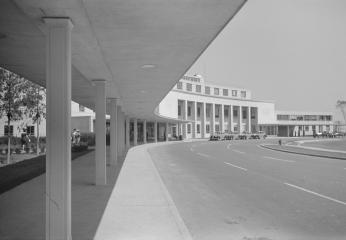
Washington National Airport Terminal in July 1941, about a month after it opened. The location of the airport was debated in Congress for 12 years. (Source: Library of Congress)
The early 20th century was marked by the fast emergence of air travel. Only two decades passed between the Wright Brothers’ first flight in North Carolina in 1903 (and subsequent training flights in Arlington, Virginia and College Park, Maryland) and airplanes being advanced enough to fly over the Lincoln Memorial dedication in 1922. A few years later, Charles Lindbergh captured the attention of the world when he flew across the Atlantic.
With the world in motion, a modern, accessible, airport quickly became a necessity for any major city, and Washington was no exception.
{snip}
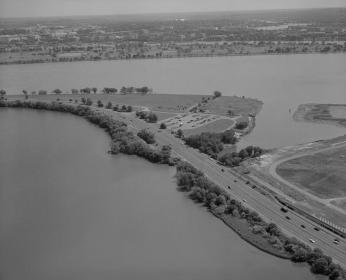
Aerial view of the Gravelly Point site. Before the airport could be built, 20 million cubic yards of sand were pumped into the site. (Source: Library of Congress)
{snip}
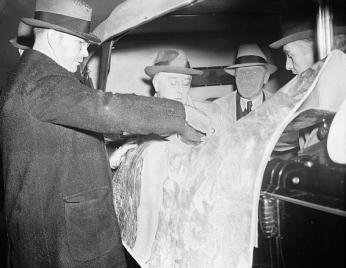
President Roosevelt looking over the plans for the new airport in Gravelly Point. Roosevelt announced that the airport would be built in 1938, ending 12 years of debate. (Source: Library of Congress)
The Gravelly Point site was chosen because it was close to the Mount Vernon Memorial Highway (now the George Washington Memorial Parkway), it provided easy access to/from Capitol Hill across the Potomac, future expansion was possible, and the site was surrounded by land already controlled by the government.[16]
Even with those advantages, however, there were still engineering challenges. Most notably, the fact that the majority of the site was underwater. So, the first step in building the airport was to make a dike around the site and fill it with material. From November 1938 to December 1939, about 20 million cubic yards of sand and gravel were pumped into the site.[17]
By 1940, this process was finished and the field was ready for use. Next came building the actual terminal. In September 28 of that year, President Roosevelt dedicated the airport, and laid the cornerstone of the terminal building amidst great fanfare.[18]
The Evening Star captured the scene as an armada of 400 planes flew overhead:
The act was a demonstration of the U.S. air might. In his speech, Roosevelt said the planes were there on a "peaceful mission," but that they were symbolic of "our determination to build up a defense on sea, and on land and in the air that is capable of overcoming any attack against us.”[20]
On Roosevelt's signal, the first plane landed on the field, it was an American Airlines plane. The company won the honor in a straw draw held a day prior to the event.[21] The second plane was from Eastern Airlines. Planes representing the Army, Navy and Coast Guard also landed on the field.
{snip}
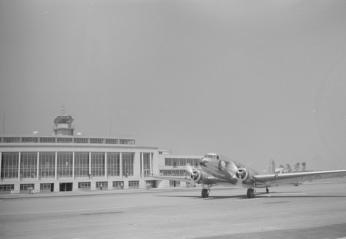
Airplane taxiing out of Washington National Airport. The airport continues to be popular and has undergone a couple of expansions. (Source: Library of Congress)
Footnotes
{snip}
16. Hooper, Carol, Elizabeth Lampl and Judith Robinson. "National Register of Historic Places Registation Form." 1995. Sec. Early Planning and Design at the Airport Site, p. 24-25. http://www.dhr.virginia.gov/registers/Counties/Arlington/000-0045_W.National_Airport_Terminal_1997_Final_Nomination.pdf
17. Metropolitan Washington Airports Authority. History of the Reagan National Airport. http://www.flyreagan.com/dca/history-reagan-national-airport
18. The Washington Post. "New Airport to Open Today." The Washington Post September 28, 1940.
19. Jones, Carter Brooke. “Unexpected Show of Aerial Might Thrills Throng at New National Airport Dedication." The Evening Star September 29, 1940.
20. The New York Times. "Text of Roosevelt Speech at Washington Airport." The New York Times September 29, 1940.
21. Metropolitan Washington Airports Authority. History of the Reagan National Airport. http://www.flyreagan.com/dca/history-reagan-national-airport
5/3/2018 / in DC, Virginia / by Laura Castro Lindarte

Washington National Airport Terminal in July 1941, about a month after it opened. The location of the airport was debated in Congress for 12 years. (Source: Library of Congress)
The early 20th century was marked by the fast emergence of air travel. Only two decades passed between the Wright Brothers’ first flight in North Carolina in 1903 (and subsequent training flights in Arlington, Virginia and College Park, Maryland) and airplanes being advanced enough to fly over the Lincoln Memorial dedication in 1922. A few years later, Charles Lindbergh captured the attention of the world when he flew across the Atlantic.
With the world in motion, a modern, accessible, airport quickly became a necessity for any major city, and Washington was no exception.
{snip}

Aerial view of the Gravelly Point site. Before the airport could be built, 20 million cubic yards of sand were pumped into the site. (Source: Library of Congress)
{snip}

President Roosevelt looking over the plans for the new airport in Gravelly Point. Roosevelt announced that the airport would be built in 1938, ending 12 years of debate. (Source: Library of Congress)
The Gravelly Point site was chosen because it was close to the Mount Vernon Memorial Highway (now the George Washington Memorial Parkway), it provided easy access to/from Capitol Hill across the Potomac, future expansion was possible, and the site was surrounded by land already controlled by the government.[16]
Even with those advantages, however, there were still engineering challenges. Most notably, the fact that the majority of the site was underwater. So, the first step in building the airport was to make a dike around the site and fill it with material. From November 1938 to December 1939, about 20 million cubic yards of sand and gravel were pumped into the site.[17]
By 1940, this process was finished and the field was ready for use. Next came building the actual terminal. In September 28 of that year, President Roosevelt dedicated the airport, and laid the cornerstone of the terminal building amidst great fanfare.[18]
The Evening Star captured the scene as an armada of 400 planes flew overhead:
"In a single thrilling minute, the military planes converged over the airport from seven different directions and at as many altitudes. They came with such headlong speed and at so many angles that many a spectator held his breath lest they crash. But the breath-taking maneuver was managed perfectly."[19]
The act was a demonstration of the U.S. air might. In his speech, Roosevelt said the planes were there on a "peaceful mission," but that they were symbolic of "our determination to build up a defense on sea, and on land and in the air that is capable of overcoming any attack against us.”[20]
On Roosevelt's signal, the first plane landed on the field, it was an American Airlines plane. The company won the honor in a straw draw held a day prior to the event.[21] The second plane was from Eastern Airlines. Planes representing the Army, Navy and Coast Guard also landed on the field.
{snip}

Airplane taxiing out of Washington National Airport. The airport continues to be popular and has undergone a couple of expansions. (Source: Library of Congress)
Footnotes
{snip}
16. Hooper, Carol, Elizabeth Lampl and Judith Robinson. "National Register of Historic Places Registation Form." 1995. Sec. Early Planning and Design at the Airport Site, p. 24-25. http://www.dhr.virginia.gov/registers/Counties/Arlington/000-0045_W.National_Airport_Terminal_1997_Final_Nomination.pdf
17. Metropolitan Washington Airports Authority. History of the Reagan National Airport. http://www.flyreagan.com/dca/history-reagan-national-airport
18. The Washington Post. "New Airport to Open Today." The Washington Post September 28, 1940.
19. Jones, Carter Brooke. “Unexpected Show of Aerial Might Thrills Throng at New National Airport Dedication." The Evening Star September 29, 1940.
20. The New York Times. "Text of Roosevelt Speech at Washington Airport." The New York Times September 29, 1940.
21. Metropolitan Washington Airports Authority. History of the Reagan National Airport. http://www.flyreagan.com/dca/history-reagan-national-airport
InfoView thread info, including edit history
TrashPut this thread in your Trash Can (My DU » Trash Can)
BookmarkAdd this thread to your Bookmarks (My DU » Bookmarks)
1 replies, 660 views
ShareGet links to this post and/or share on social media
AlertAlert this post for a rule violation
PowersThere are no powers you can use on this post
EditCannot edit other people's posts
ReplyReply to this post
EditCannot edit other people's posts
Rec (2)
ReplyReply to this post
1 replies
 = new reply since forum marked as read
Highlight:
NoneDon't highlight anything
5 newestHighlight 5 most recent replies
= new reply since forum marked as read
Highlight:
NoneDon't highlight anything
5 newestHighlight 5 most recent replies
On this day, September 28, 1940, FDR laid the cornerstone of Washington National Airport. (Original Post)
mahatmakanejeeves
Sep 2023
OP
mahatmakanejeeves
(60,970 posts)1. Who would I like to see it named for?
Sat Sep 28, 2019: My vote for a long time has been George C. Marshall.
George Marshall
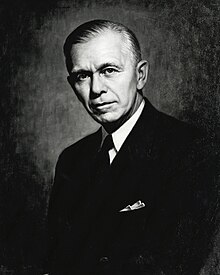
3rd United States Secretary of Defense
Personal details
Born: George Catlett Marshall, December 31, 1880; Uniontown, Pennsylvania, U.S.
Died: October 16, 1959 (aged 78); Washington, D.C., U.S.
Political party: Independent
Education: Virginia Military Institute (BS)
{snip the rest}
George Catlett Marshall Jr. (December 31, 1880 – October 16, 1959) was an American soldier and statesman. He rose through the United States Army to become Chief of Staff under presidents Franklin D. Roosevelt and Harry S. Truman, then served as Secretary of State and Secretary of Defense under Truman. Winston Churchill lauded Marshall as the "organizer of victory" for his leadership of the Allied victory in World War II, although Marshall declined a final field leadership position that went to his protégé, later U.S. President, Dwight D. Eisenhower. After the war, as Secretary of State, Marshall advocated a significant U.S. economic and political commitment to post-war European recovery, including the Marshall Plan that bore his name. In recognition of this work, he was awarded the Nobel Peace Prize in 1953.
{snip}

1900 VMI Keydets football team. Marshall encircled
{snip}

3rd United States Secretary of Defense
Personal details
Born: George Catlett Marshall, December 31, 1880; Uniontown, Pennsylvania, U.S.
Died: October 16, 1959 (aged 78); Washington, D.C., U.S.
Political party: Independent
Education: Virginia Military Institute (BS)
{snip the rest}
George Catlett Marshall Jr. (December 31, 1880 – October 16, 1959) was an American soldier and statesman. He rose through the United States Army to become Chief of Staff under presidents Franklin D. Roosevelt and Harry S. Truman, then served as Secretary of State and Secretary of Defense under Truman. Winston Churchill lauded Marshall as the "organizer of victory" for his leadership of the Allied victory in World War II, although Marshall declined a final field leadership position that went to his protégé, later U.S. President, Dwight D. Eisenhower. After the war, as Secretary of State, Marshall advocated a significant U.S. economic and political commitment to post-war European recovery, including the Marshall Plan that bore his name. In recognition of this work, he was awarded the Nobel Peace Prize in 1953.
{snip}

1900 VMI Keydets football team. Marshall encircled
{snip}